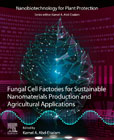
Fungal Cell Factories for Sustainable Nanomaterials Productions and Agricultural Applications
Abd-Elsalam, Kamel A.
Fungal Cell Factories for Sustainable Nanomaterials Productions and Agricultural Applications explores the mycogenic synthesis of many metal nanoparticles, including processing processes, environmental protection, and future perspectives. Nanomaterials, including silver, gold, palladium, copper, zinc, selenium, titanium dioxide, metal sulphide, cellulose, have been formed by major fungal genes, such as mushrooms, Fusarium, Trichoderma, endophytic fungi, and yeast, in addition to lichens. Understanding the exact process involved in the synthesis of nanoparticles and the effects of various factors on the reduction of metal ions can help to improve low-cost strategies for the synthesis and extraction of nanoparticles. Other sections focus on a new framework for the production of nano-antimicrobial, the use of myconanoparticles against plant diseases, post-harvest antibiotics, mycotoxin control and plant pests in addition to certain animal pathogens. Myconanomaterials are well developed with great potential and promise for advanced diagnostics, biosensors, precision farming and targeted smart delivery systems. Assesses the impact of a variety of copper-based nanostructures on agri-food sectors, addressing the most relevant knowledge gaps Explores the opportunities that myconanotechnology can provide for industrial applications Explains the major challenges of applying myconanotechnology at an industrial scale INDICE: 1. Fungal nanotechnology for improving farm productivity and sustainability Part 1: Synthesis various types of NMs 2. Fungal synthesis of gold nanoparticles and their applications 3. Fungal synthesis of palladium nanoparticles and their applications 4. Fungal synthesis of silver nanoparticles 5. Fungal synthesis of copper nanoparticles and applications 6. Fungal synthesis of zinc nanoparticles and applications in biomedical, environmental, and agri-food sectors 7. Myco fabricated nanomaterials: Enzyme Mediated Extracellular and Intracellular Synthesis Mechanisms 8. Synthesis of metal nanoparticles using lichens 9. Mushroom factories for the production metal nanoparticles and their antimicrobial applications 10. Fungal synthesis of selenium nanoparticles 11. Myco synthesis of titanium dioxide (TiO2) nanoparticles and their applications 12. Bio synthesis of metal sulfide nanoparticles via microorganisms and their applications 13. Nanocellulose production using fungi and its applications 14. Yeast Cells as a Controllable synthesizer for Bio nanoparticles and Nanocomposites 15. Are beneficial fungi like Trichoderma a safe producer for metal nanoparticles? 16. Endophytic fungi as eco-synthesizer of various nanoparticles 17. Mycogenic Nanoparticles, risk assessment, safety and regulation Part 2: Applications 18. Myco synthesis of metal-based nanoparticles and their perspective exploitation in veterinary medicine and agriculture 19. Fungi mediated nanoparticles: A review on its role in stress induced responses in plants 20. Nanobiotechnological strategies for detection of fungi and mycotoxins in food and feed 21. Fungal nanobionics: Principle, advances and applications. 22. Antimicrobial application of myco-nanotechnology 23. Role of fungi mediated nanoparticles in mitigation of biotic and abiotic stresses. 24. Mycogenic Nanoparticles and Their Application as Antimicrobial and Antibiofilm Agents in post-harvest Stage 25. Applications of fungal nanobiotechnology in veterinary drug control 26. Myco nanotechnology applications in the veterinary sector 27. Current updates of nanotechnology in myco remediation of environmental pollutants 28. Myco synthesized Nanoparticles: Role in Food Processing Industries 29. Advances in nanotechnology-based strategies for the identification of pathogenic fungi 30. Commercialization and economics aspects of fungal nanobiotechnology in multidisciplinary applications
- ISBN: 978-0-323-99922-9
- Editorial: Elsevier
- Encuadernacion: Rústica
- Páginas: 750
- Fecha Publicación: 15/09/2022
- Nº Volúmenes: 1
- Idioma: Inglés
